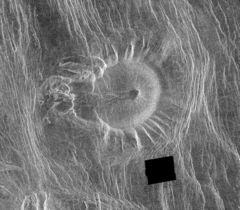
Scalloped margin dome
Encyclopedia

Volcano
2. Bedrock3. Conduit 4. Base5. Sill6. Dike7. Layers of ash emitted by the volcano8. Flank| 9. Layers of lava emitted by the volcano10. Throat11. Parasitic cone12. Lava flow13. Vent14. Crater15...
dome that has experienced collapse and mass wasting
Mass wasting
Mass wasting, also known as slope movement or mass movement, is the geomorphic process by which soil, regolith, and rock move downslope under the force of gravity. Types of mass wasting include creep, slides, flows, topples, and falls, each with its own characteristic features, and taking place...
such as landslides on its perimeter. The margins of these domes have headscarps or 'scallops' separated by ridge
Ridge
A ridge is a geological feature consisting of a chain of mountains or hills that form a continuous elevated crest for some distance. Ridges are usually termed hills or mountains as well, depending on size. There are several main types of ridges:...
s that are a consequence of adjoining scallops. Sometimes debris or slumping can be found at the bottom of these scarps or scattered many tens of kilometers away. Many examples show no debris at all. The center of these domes is often, but not always, a depression. There is another theory that the radial ridges of scalloped margin domes are volcanic dike
Dike (geology)
A dike or dyke in geology is a type of sheet intrusion referring to any geologic body that cuts discordantly across* planar wall rock structures, such as bedding or foliation...
s.
During the first month of data from the Magellan
Magellan probe
The Magellan spacecraft, also referred to as the Venus Radar Mapper, was a 1,035-kilogram robotic space probe launched by NASA on May 4, 1989, to map the surface of Venus using Synthetic Aperture Radar and measure the planetary gravity...
spacecraft, the first of these features was found to the northeast of Alpha Regio, on Venus
Venus
Venus is the second planet from the Sun, orbiting it every 224.7 Earth days. The planet is named after Venus, the Roman goddess of love and beauty. After the Moon, it is the brightest natural object in the night sky, reaching an apparent magnitude of −4.6, bright enough to cast shadows...
. It was one of the largest of these domes and therefore stood out. The strange feature was originally dubbed by the Magellan Project Science Team
Magellan Project Science Team
The Magellan Project Science Team consisted of Dr. R. Stephen Saunders, the Project Scientist; Dr. Ellen Stofan, the Deputy Project Scientist; research assistants Tim Parker, Dr...
, The Tick, because the many radiating ridges resembled the legs of a tick
Tick
Ticks are small arachnids in the order Ixodida, along with mites, constitute the subclass Acarina. Ticks are ectoparasites , living by hematophagy on the blood of mammals, birds, and sometimes reptiles and amphibians...
. Its concavity was likely confused as domelike as a tick's body, instead of the actuality which is that it is a bowl-shaped depression. Through the first year of Magellan
Magellan probe
The Magellan spacecraft, also referred to as the Venus Radar Mapper, was a 1,035-kilogram robotic space probe launched by NASA on May 4, 1989, to map the surface of Venus using Synthetic Aperture Radar and measure the planetary gravity...
image data The Tick was thought to be a unique feature until an aide to the science team catalogued inconspicuous similar features all over Venus. This resulted in referring to the features as 'ticks' which was later changed to 'scalloped margin domes'.

